Tue 20 Sep 2016
A Movie Review by Jonathan Lewis: MURDERS IN THE RUE MORGUE (1971).
Posted by Steve under Horror movies , Reviews[4] Comments
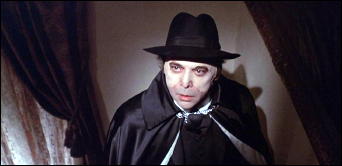
MURDERS IN THE RUE MORGUE. American International Pictures, 1971. Jason Robards, Herbert Lom, Christine Kaufmann, Adolfo Celi, Maria Perschy, Michael Dunn, Lilli Palmer. Screenwriters: Christopher Wicking & Henry Slesar, based on the story by Edgar Allan Poe. Director: Gordon Hessler.
When adapting what many critics consider to be the original modern detective story to film, there’s a temptation to do so in a manner that adheres too closely to the original text.
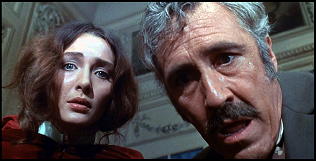
That’s definitely not a problem for Gordon Hessler’s Murders in the Rue Morgue, a film that’s so anarchic in spirit that it ends up little resembling Edgar Allan Poe’s locked door mystery. Borrowing as much from The Phantom of the Opera (1943) as from Poe’s tale, this uneven, but still enjoyable, American International production blends gothic horror, an early 1970s Paella Western aesthetic, and a sly commentary on the demarcations between the profession of acting and living in “real life.†The movie also benefits a rather unique score by the Argentine composer and conductor, Waldo de los RÃos.
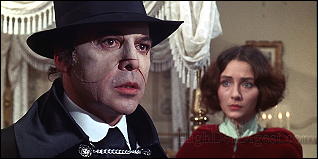
The plot revolves around an early twentieth-century Parisian theater troupe of the Grand Guignol variety. Led by the mercurial Cesar Charron (Jason Robards), the troupe includes a myriad of colorful members. In the midst of their theatrical run of a stage adaptation of Poe’s eponymous story, Charron finds that his cast and crew, both former and present, are being targeted for murder.
It’s only when the bodies start piling up that Charron begins to suspect that his former friend and rival, Rene Marot (Herbert Lom) is behind the horrific killings. Thing is: Marot is believed to be dead, having taken his own life after murdering Cesar’s wife’s, Madeline’s (Christine Kauffman) mother (Lilli Palmer) with an axe.
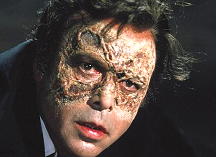
At the end of the day, however, it’s not the convoluted murder mystery plot that makes Murders in the Rue Morgue worth watching. Rather, the film is more an exercise in style and reflective of a certain type of Gothic horror cinema, one in which dreams, flashbacks, and hallucinatory sojourns play important roles in elucidating how the characters’ pasts and presents converge in tragic ways. The movie’s not a horror classic and doesn’t hold up very well when compared with Roger Corman’s Poe films, but it’s the product of a certain type of daring that was a hallmark of 1970s commercial cinema.
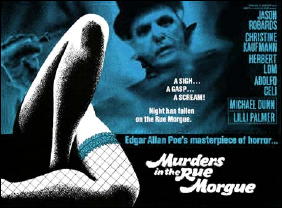
September 21st, 2016 at 11:02 am
I’ve often noticed that your credit paragraph at the top of the post almost never mentions the writer(s) of the picture in question.
Maybe the writer gets a fleeting mention in the body of the review, most often in the negative.
I saw this version of Rue Morgue in its theatrical release (I was very young then, which is my excuse), and as a lifelong credit reader, I noted that one of the screenwriters was a man of whom I was a major fan, Henry Slesar.
I know it’s a shared credit, and I don’t really know all that much about Christopher Wicking, thus I can only speculate on who did what (and when) during the actual writing.
That said, Henry Slesar and Gordon Hessler do share the Hitchcock-TV connection, which ought to mean something in the overall scheme of things.
I just thought I’d put this on the table; it seems to me that in movies writers always seem to get the short end, which is a wasteful way to do things.
September 21st, 2016 at 2:16 pm
Fair enough criticism, Mike. I include screenwriters when I recognize their names, which isn’t all that often, I’m sorry to say. Mostly they seem to be an anonymous lot, even when they’re prolific, and Wicking is only moderately so, having a mere 17 credits on IMDb.
But to spot Henry Slesar as a co-screenwriter, you have to go a followup page, and I admit to being too lazy to do so, and I should have. He’s a name I do recognize, and I’ll add both names to the top of Jon’s review. Thanks for the assist on this.
September 23rd, 2016 at 11:03 pm
It’s no PHANTOM OF THE RUE MORGUE.
August 8th, 2021 at 11:43 am
Marot did not kill Madeleine’s mother. Cesar did. What’s overlooked in most reviews is the excellent, haunting score by Osvaldo de los Rio.